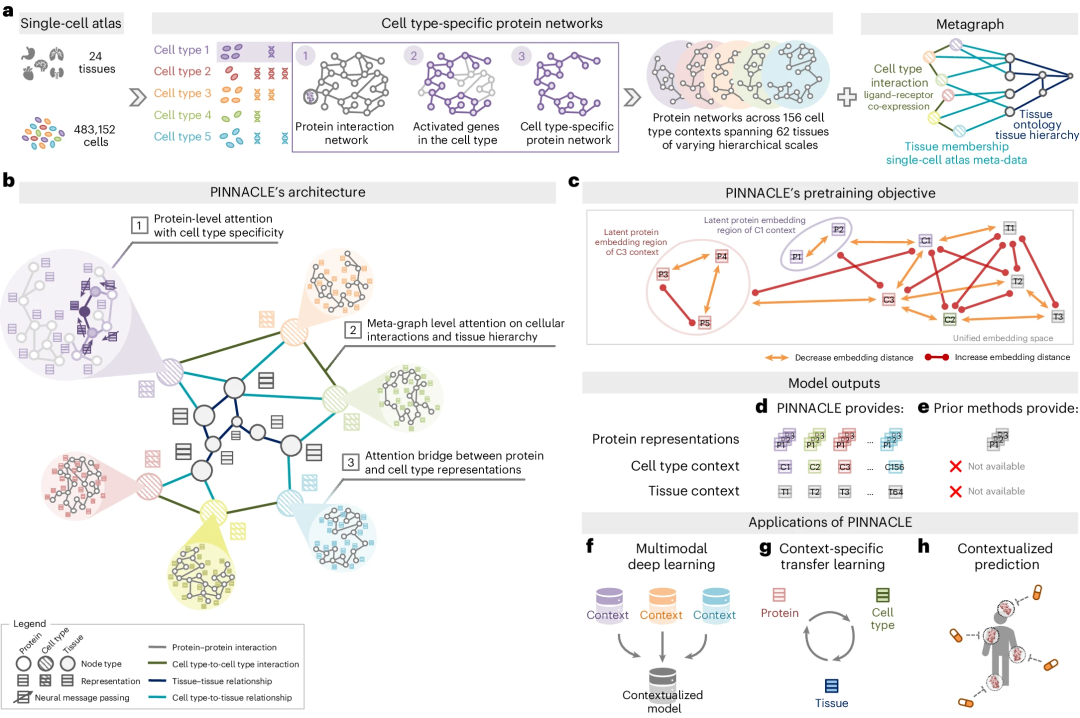Rumah >Peranti teknologi >AI >Menjana 394,760 perwakilan protein, pasukan Harvard membangunkan model AI untuk memahami konteks protein sepenuhnya
Menjana 394,760 perwakilan protein, pasukan Harvard membangunkan model AI untuk memahami konteks protein sepenuhnya
- WBOYWBOYWBOYWBOYWBOYWBOYWBOYWBOYWBOYWBOYWBOYWBOYWBasal
- 2024-07-26 20:20:141283semak imbas

Understanding protein function and developing molecular therapies requires identifying the cell types in which proteins play a role and analyzing the interactions between proteins.
However, modeling protein interactions across biological contexts remains challenging for existing algorithms.
In the latest study, researchers at Harvard Medical School developed PINNACLE, a geometric deep learning method for generating context-aware protein representations.
PINNACLE leverages multi-organ single cell atlases to learn on contextualized protein interaction networks, generating 394,760 protein representations from 156 cell type contexts across 24 tissues.
The study was titled "Contextual AI models for single-cell protein biology" and was published in "Nature Methods" on July 22, 2024.

- Proteins are the basic functional units of cells and achieve biological functions through interactions.
- High-throughput technologies have driven the mapping of protein interaction networks and improved understanding of protein structure, function and target design through computational methods.
- Indicates that the learning method integrates molecular cell atlases, can analyze protein interaction networks, and expands the understanding of protein functions.
Context-dependent protein function
- Proteins play different roles in different biological contexts, and gene expression and function vary according to health and disease states.
- Background-free protein means that functional changes between cell types cannot be identified, affecting prediction accuracy.
Single Cell Gene Expression and Protein Network
- Sequencing technology measures single cell gene expression, paving the way for solving context-dependent problems.
- Attention-based deep learning can focus on large inputs and learn important elements in the context.
- Single cell atlas can enhance the mapping of gene regulatory networks related to disease progression and reveal targets.
PINNACLE MODEL
- There are still challenges in integrating protein-coding gene expression into protein interaction networks.
- PINNACLE model provides context-specific understanding of proteins.
- PINNACLE is a geometric deep learning model that generates protein representations by analyzing protein interactions in cellular environments.
1. PINNACLE Overview
Illustration: PINNACLE Overview. (Source: Paper)
2. Contextualized Protein Representation
PINNACLE is trained on an integrated context-aware PPI network, supplemented by a network that captures cellular interactions and tissue hierarchies, to generate protein representations customized for cell types .
3. Multi-scale representation
Unlike context-free models, PINNACLE generates multiple representations for each protein, depending on its cell type context. Additionally, PINNACLE generates cell type context and tissue-level representations.
4. Multi-scale learning
PINNACLE learns the topology of proteins, cell types and tissues by optimizing a unified latent representation space.
5. Context-Aware Models
PINNACLE integrates context-specific data into a single model and transfers knowledge between protein, cell type and tissue-level data.
6. Embedding Space
To inject cellular and tissue information into the embedding space, PINNACLE employs protein, cell type, and tissue level attention.
7. Physical interaction mapping
Physically interacting protein pairs are tightly embedded in the embedding space.
8. Cell Type Environment
Proteins are embedded near their cell type environment.
9. Graph Neural Network Propagation
PINNACLE propagates information between proteins, cell types and tissues using an attention mechanism customized for each node and edge type.

Tugas pra-latihan jenis sel dan khusus tisu PINNACLE bergantung sepenuhnya pada ramalan pautan yang diselia sendiri untuk memudahkan pembelajaran organisasi sel dan tisu. Topologi jenis sel dan tisu dihantar ke perwakilan protein melalui mekanisme merapatkan perhatian, dengan berkesan mengukuhkan tisu dan organisasi sel ke perwakilan protein.
Perwakilan protein kontekstual PINNACLE menangkap struktur rangkaian interaksi protein yang sedar konteks. Susunan serantau bagi perwakilan protein kontekstual ini dalam ruang terpendam mencerminkan organisasi selular dan tisu yang diwakili oleh metagraf. Ini akan membawa kepada perwakilan yang komprehensif dan konteks khusus bagi protein dalam jenis sel bersatu dan rangka kerja khusus tisu.
Dengan 394,760 perwakilan protein kontekstual yang dijana oleh PINNACLE, setiap satunya adalah khusus jenis sel, penyelidik menunjukkan keupayaan PINNACLE untuk menggabungkan interaksi protein dengan transkrip gen pengekodan protein yang mendasari 156 konteks jenis sel.
Ruang benam PINNACLE mencerminkan struktur selular dan tisu, membolehkan pengambilan sifar tangkapan hierarki tisu. Perwakilan protein yang telah dilatih boleh disesuaikan dengan tugas hiliran: meningkatkan perwakilan berasaskan struktur 3D untuk menyelesaikan interaksi protein imuno-onkologi dan mengkaji kesan ubat pada jenis sel yang berbeza.
PINNACLE mengatasi prestasi model terkini dalam menentukan sasaran terapeutik untuk arthritis rheumatoid dan penyakit radang usus, dan mempunyai kuasa ramalan yang lebih tinggi daripada model tanpa konteks untuk menentukan konteks jenis sel. Keupayaan PINNACLE untuk menyesuaikan outputnya kepada persekitaran di mana ia beroperasi membuka jalan untuk ramalan khusus konteks berskala besar dalam biologi.
Pautan kertas: https://www.nature.com/articles/s41592-024-02341-3
Atas ialah kandungan terperinci Menjana 394,760 perwakilan protein, pasukan Harvard membangunkan model AI untuk memahami konteks protein sepenuhnya. Untuk maklumat lanjut, sila ikut artikel berkaitan lain di laman web China PHP!
Artikel berkaitan
Lihat lagi- Aliran teknologi untuk ditonton pada tahun 2023
- Cara Kecerdasan Buatan Membawa Kerja Baharu Setiap Hari kepada Pasukan Pusat Data
- Bolehkah kecerdasan buatan atau automasi menyelesaikan masalah kecekapan tenaga yang rendah dalam bangunan?
- Pengasas bersama OpenAI ditemu bual oleh Huang Renxun: Keupayaan penaakulan GPT-4 belum mencapai jangkaan
- Bing Microsoft mengatasi Google dalam trafik carian terima kasih kepada teknologi OpenAI


